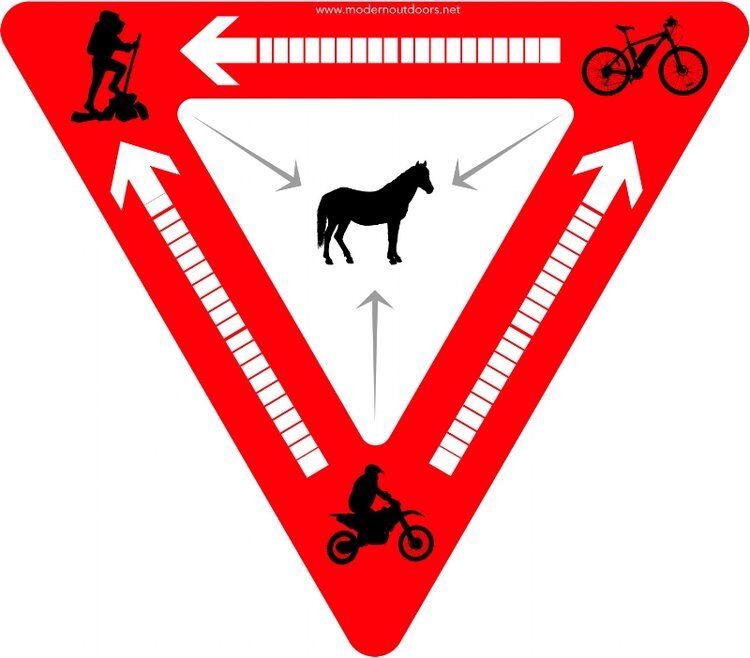Trail Etiquette 101: How To Share Like A Big Kid
We share roads, elevators, and park benches. From a young age, we learn to share with others so we can function in a burgeoning society.
City structures aren’t all we share. We're sharing open spaces at an increasing rate, and the outdoors are a prime example of that. Walkers, runners, hikers, backpackers, climbers, mountain bikers, animal riders, and off-highway vehicles (OHVs) all use the same trails. It can get a little crowded.
There’s a system of etiquette we all follow to make sure everyone can use the trail without kicking up dust.
Note: Walkers, runners, backpackers, and climbers, are included in the “hikers” category.
Etiquette For Everyone
Know when (and how) to yield.
Hikers yield to horses. Mountain bikers yield to hikers and horses. OHVs yield to mountain bikers, hikers, and horses. Horses ain't gonna yield to no-damn-body.
When yielding to a horse, approach slowly. Horses are prey animals and will try to run uphill if they think you're a predator. Give a wide berth. Walk downhill, off-trail. Talk to the horse or their rider in a friendly tone.
Downhill trail users yield to uphill trail users.
Let people know that you’re creeping on them.
Move over to the right, pass on the left.
Stay on designated trails. Don’t cut through switchbacks when there’s a path in front of you.
Report vandalism. If you catch someone in the act, stop them.
Be friendly to other trail users. Smile, say hello, sing Kumbayah.
Don’t feed the wildlife. I don’t care how cute you think it is. Human food causes serious digestive issues, and the lack of fear makes them easy prey.
Walk at least 200 feet from the trail when responding to “nature’s call.”
Leave no trace. Practice these seven principles:
Plan ahead. Prepare for your trip by gathering intel so you know what to expect should an emergency happen. Bring cookies.
Travel on durable surfaces. Trails, roads, slick rock, gravel, ice. Anything that can scrape you up if you stumble.
Dispose of your waste. Bury your poo as deep as your most shameful secrets.
Leave what you find. I know that rock is pretty. Photograph it. Don’t bring it home to use as a paperweight.
Reduce campfire impact. Enjoying a campfire is great. Enjoying a forest fire is not.
Respect wildlife. No matter how scared and cold that bison calf looks, it doesn't belong in the back of your car.
Be considerate. We all get frisky. Do us a favor and find some shrubbery to muffle your mating call.
Etiquette For Hikers
When in a group, hike single-file. Don’t take up more than half the width of the trail.
Use cairns to mark a route or destination. If you want to build rock art, take a photo and dismantle it.
Control your pets. Keep them on-leash unless otherwise designated. Pick up their poop immediately- don’t leave the bag to pick up later.
If you stop for any reason, step to the side of the trail so others can pass.
Let faster hikers pass you. Step aside so they can pass on the left.
Etiquette For Mountain Bikers
When yielding to a horse, dismount before walking around the animal. Removing your helmet can also be disarming.
Let others know you’re coming with a jovial greeting, ringing your bell, or shouting “on your left.” Don’t hug the side of the trail waving your arm, expecting others to see and pass you. It’s your responsibility to make your presence known.
If you’re in a group, let oncoming trail users know how many bikers are behind you. You can show remaining bikers using your fingers, or by telling them. If you’re the last, say “I’m the last one.”
Stay in control. Make sure you can operate the bike within your abilities. Don’t attempt a black diamond trail if you’re a novice rider.
Etiquette For Horse Riders
Use designated equine trails. Someone was kind enough to build those for you. You might as well use them.
Try to avoid muddy trails. If you can't, walk your horse through the trail slowly.
Clean up your horse shit. Like dog poop, don’t leave your horse’s poop on the trail. Jump down, kick it off the trail, and be on your merry way.
Control your animal. Avoid bringing inexperienced horses to popular trails. Put inexperienced horses in the back, and inexperienced riders in the middle.
Be patient with other trail users. They might not know how to handle the encounter. Be friendly and use it as an opportunity to educate them.
Etiquette For OHV Drivers
When yielding, slow down to reduce dust.
When yielding to a horse, ask the rider if it’s safe to pass. Kill the engine and remove your helmet. When you ride by, keep your RPMs low.
Take your vehicle on trails designated for that specific type of vehicle.
If you’re in a group, let oncoming trail users know how many riders are behind you. You can show the remaining riders by using your fingers or holding up a fist to show you’re the last one.
We’ve all fallen victim to bad etiquette at some time or another. It’s part of being human. But we also learn from a young age that practice makes perfect. If you’re going to learn anything from this, let it be that we all enjoy the outdoors. We want to keep them hospitable as long as possible.
Did we miss anything? Let us know in the comments.






